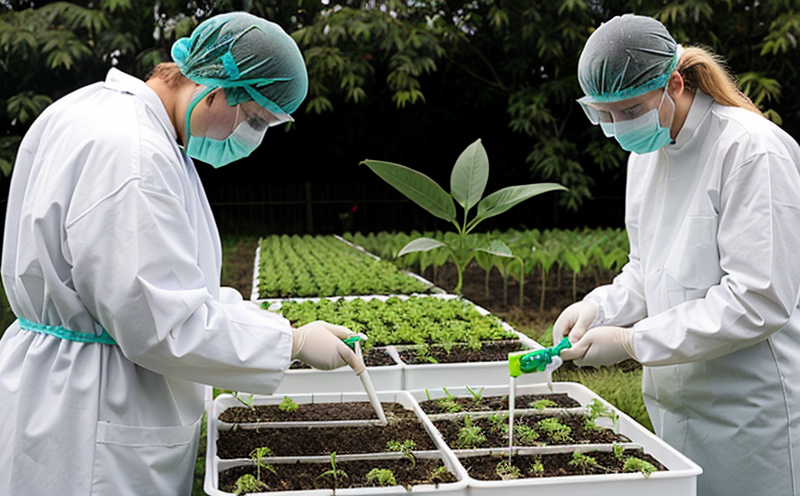Xanthomonas Campestris (Black Rot) Testing
The Xanthomonas campestris bacterium is a significant pathogen affecting various crops in the Brassicaceae family, notably cabbage and cauliflower. Black rot disease, caused by this bacterium, results in severe economic losses due to yield reduction and quality degradation. This service provides comprehensive testing for Xanthomonas campestris, ensuring that agricultural products are free from this pathogen.
The detection of Xanthomonas campestris is critical, especially in regions where the Brassicaceae family is a major crop. The bacterium can spread through contaminated seeds and irrigation water, leading to epidemics if not controlled. This service ensures that agricultural products meet strict quality standards set by international regulatory bodies.
Our laboratory employs advanced molecular techniques such as polymerase chain reaction (PCR) and loop-mediated isothermal amplification (LAMP), which are highly sensitive for detecting Xanthomonas campestris. These methods allow us to identify the pathogen even in low concentrations. Additionally, we use serological tests like enzyme-linked immunosorbent assay (ELISA) to complement our molecular testing.
The testing process begins with the collection of plant samples from affected areas or during routine inspections. Samples are then prepared by washing them thoroughly and extracting bacterial cells using a mechanical homogenizer. The extracted DNA is subjected to PCR amplification, followed by gel electrophoresis for visualization of specific Xanthomonas campestris sequences.
The use of LAMP technology allows us to amplify target sequences in a single reaction without the need for thermal cycling equipment, making it faster and more cost-effective. ELISA tests are performed on extracted proteins from plant tissues suspected of containing the pathogen. This multi-method approach ensures high accuracy and reliability in our testing.
The results from these tests are detailed in comprehensive reports that include sample identification, test methods used, and interpretation of results against established thresholds. Compliance with international standards such as ISO 16140-5:2023 (Microbiology of food and animal feeding stuffs — Isolation media for the detection of selected enterobacteria) ensures our testing meets global quality benchmarks.
By partnering with us, stakeholders can ensure their agricultural products are free from Xanthomonas campestris, thus maintaining market access and consumer confidence. Our rigorous testing protocols not only protect individual producers but also contribute to broader food safety initiatives.
Applied Standards
| Standard | Description |
|---|---|
| ISO 16140-5:2023 | Microbiology of food and animal feeding stuffs — Isolation media for the detection of selected enterobacteria |
| ASTM D7849 | Determination of Xanthomonas campestris on seeds by real-time PCR |
| EN ISO 15068-2:2013 | Bacteriological quality of water intended for human consumption — Part 2: Methods for the enumeration and isolation of coliform bacteria, E. coli and other indicator organisms in water intended for human consumption |
| IEC TS 62785-10 | Diagnostics of medical electrical equipment in patient environments — Part 10: Infection control testing |
Benefits
Implementing the Xanthomonas campestris (Black Rot) Testing service brings numerous benefits to stakeholders involved in agriculture and forestry. These include:
- Enhanced Crop Quality: By eliminating Xanthomonas campestris, agricultural products retain their optimal quality, enhancing marketability.
- Avoidance of Economic Losses: Preventing outbreaks reduces the risk of significant economic losses due to disease spread and crop failure.
- Compliance with Regulations: Adhering to international standards ensures compliance with regulatory requirements, facilitating easier export and import processes.
- Consumer Confidence: Free from pathogens, agricultural products instill consumer confidence in the safety of food products.
- Environmental Protection: Controlling the spread of Xanthomonas campestris minimizes environmental pollution and supports sustainable agricultural practices.
The testing service is a proactive measure that helps stakeholders maintain high standards in their operations, thereby contributing to a robust agricultural sector.
Customer Impact and Satisfaction
Our customers benefit from our Xanthomonas campestris (Black Rot) Testing service through various means:
- Increased Market Access: Free from pathogens, agricultural products can be exported to international markets with ease.
- Improved Reputation: Demonstrating compliance and quality standards enhances the reputation of our customers in the industry.
- Reduced Risk: Early detection and elimination of Xanthomonas campestris reduce risks associated with disease spread.
- Sustainable Operations: Our service supports sustainable agricultural practices by preventing environmental degradation.
- Patient Safety: In the context of medical diagnostics, our testing ensures infection control standards are met, safeguarding patient health.
We strive to provide exceptional customer satisfaction through accurate and reliable testing services. Our goal is to partner with stakeholders in ensuring their operations meet the highest quality standards.





